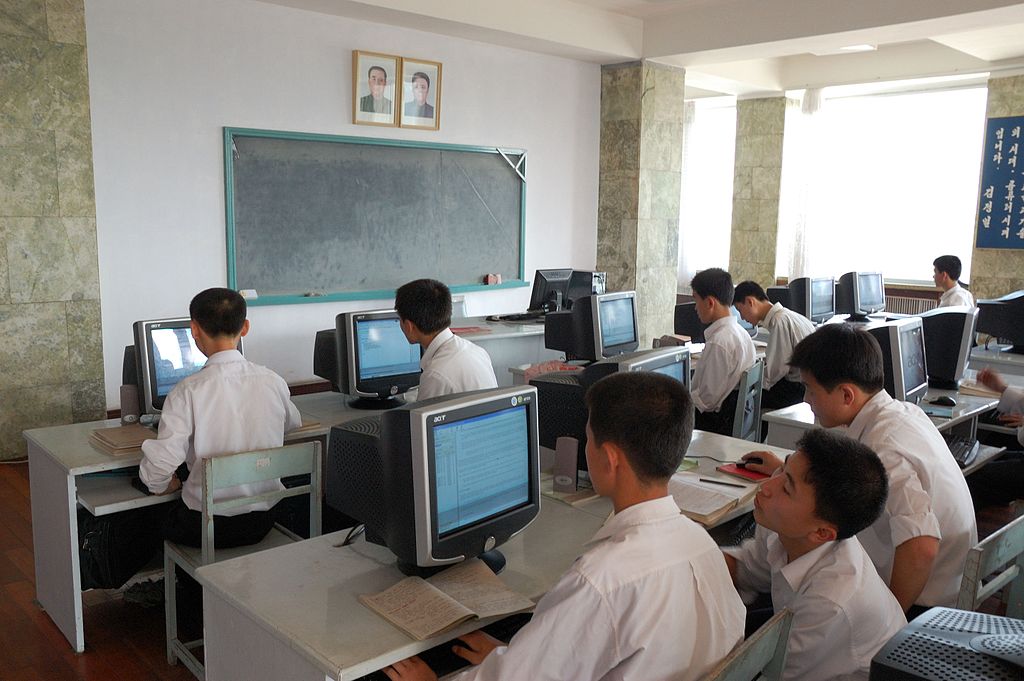North Korea Now Has A Cyber Army Of 8,400 Hackers

Kim is also allegedly collaborating with his northern Russian friend to further develop their joint malware arsenal
Mihir Bagwe July 31, 2024 Cyber Warfare, Cybersecurity News, Firewall Daily

Youngsters learning computers in Schoolchildren’s Palace, Pyongyang, North Korea (Source Wikimedia)
Share on LinkedInShare on Twitter
North Korea’s cyber capabilities are expanding at an alarming rate, posing a significant threat to global security. Local media in South Korea citing a recent intelligence report, confirmed that the reclusive nation has bolstered its cyber workforce by 20% in just two years, bringing the total number of hackers to a staggering 8,400. This number stood at 6,800 personnel, as per the Defense Whitepaper 2022.
This rapid growth, fueled by economic desperation and Kim Jong Un’s strategic vision, has transformed cyber warfare into a cornerstone of the regime’s ambitions.
North Korea’s ‘Hacker University’
The Reconnaissance General Bureau, the regime’s intelligence arm, is at the heart of this cyber expansion. Operating under the direct supervision of Kim Jong Un, the bureau has established a “hacker university” to cultivate a new generation of cyber talent. By relaxing strict social hierarchies, North Korea has opened up opportunities for individuals from all walks of life to join the program, creating a deep pool of potential recruits.
Jong Un reportedly instructed to not consider background while training hackers and select only talented individuals. In North Korea, social status, such as residence and occupation, is usually strictly determined based on bloodline, but he declared that exceptions would be made for only those who join the hacking training program. Pyongyang’s leadership is on the lookout of young math and computer talents to lead them down the path of cybercrime.
The regime’s motivation is clear: financial gain. With international sanctions crippling the North Korean economy, cybercrime has emerged as a critical revenue stream. Hacking groups such as Lazarus and Kimsuky, linked to the Reconnaissance General Bureau, have become notorious for their audacious attacks, targeting everything from cryptocurrency exchanges to government agencies. The proceeds from these cyberheists are funneled directly into the regime’s nuclear and missile programs.
A senior intelligence source referring to the mount of money that hacking can bring, assessed that “the North Korean leadership has high expectations [from these hackers].”
Developing Malware with Russia?
The burgeoning partnership between North Korea and Russia is another cause of serious concerns. The recent signing of a comprehensive strategic partnership treaty, which includes provisions for cooperation in information and communications technology security, suggests a formal framework for cyber collaboration. The intelligence authorities believe that the two have already laid the foundation for joint research and mutual education on hacking technology through this treaty.
A government source said, “It appears that North Korea and Russia are jointly developing or sharing core malware used in hacking.” This alliance could lead to a dangerous exchange of expertise and resources, potentially elevating the threat level posed by both nations.
Experts warn that North Korea’s cyber tactics are becoming increasingly sophisticated and aggressive. The regime is no longer content with targeting specific, high-value targets. Instead, it is adopting a broader, more indiscriminate approach, casting a wider net in search of vulnerable systems. This shift in strategy, coupled with the rapid growth of its cyber workforce, makes North Korea a formidable and unpredictable adversary in the digital realm.
As North Korea continues to invest heavily in its cyber capabilities, the international community must remain vigilant. Developing robust cybersecurity defenses, sharing intelligence, and imposing stricter sanctions on the regime are essential steps in mitigating this growing threat.





